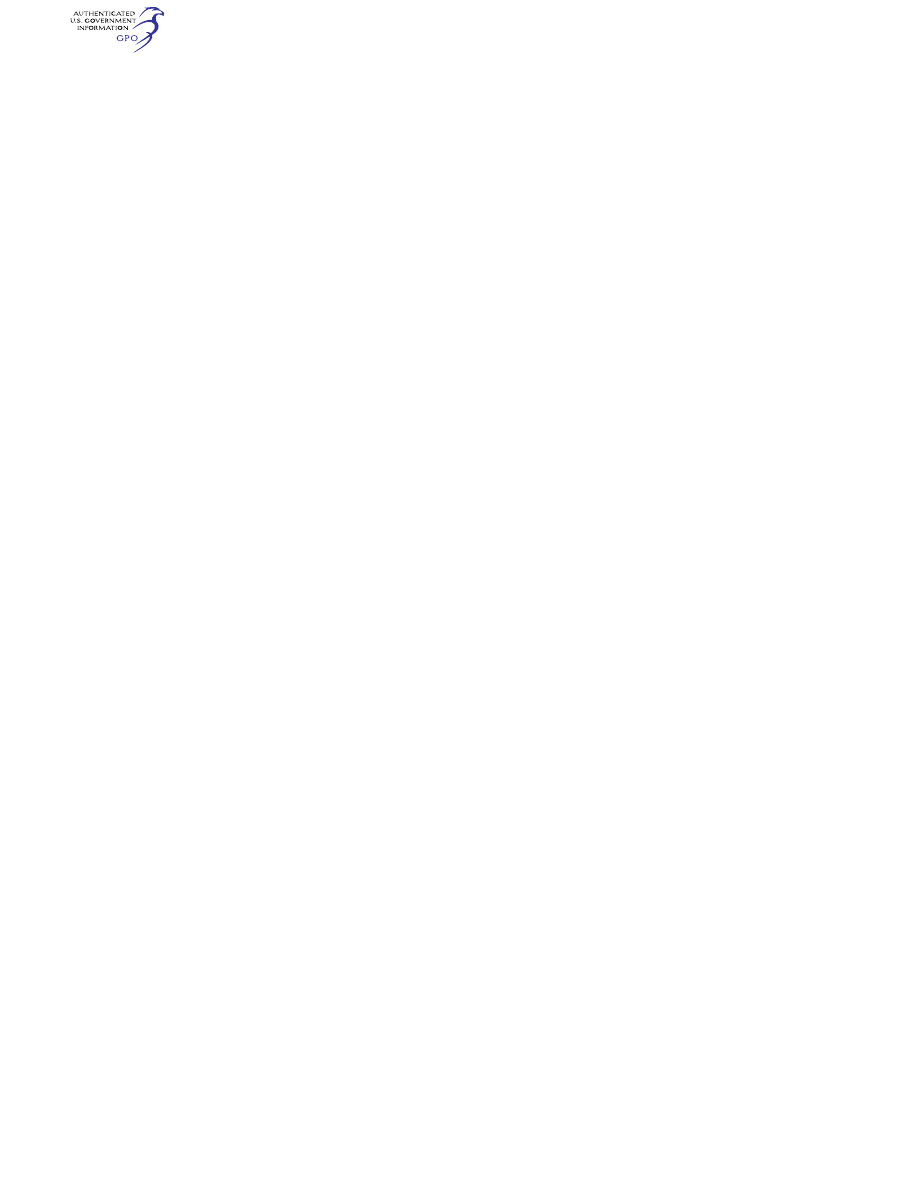
140
14 CFR Ch. I (1–1–24 Edition)
§ 121.341
event the flight terminates in that
water.
[Doc. No. 6713, 31 FR 1147, Jan. 28, 1966, as
amended by Amdt. 121–25, 32 FR 3223, Feb. 24,
1967; Amdt. 121–251, 60 FR 65932, Dec. 20, 1995]
§ 121.341 Equipment for operations in
icing conditions.
(a) Except as permitted in paragraph
(c)(2) of this section, unless an airplane
is type certificated under the transport
category airworthiness requirements
relating to ice protection, or unless an
airplane is a non-transport category
airplane type certificated after Decem-
ber 31, 1964, that has the ice protection
provisions that meet section 34 of ap-
pendix A of part 135 of this chapter, no
person may operate an airplane in
icing conditions unless it is equipped
with means for the prevention or re-
moval of ice on windshields, wings, em-
pennage, propellers, and other parts of
the airplane where ice formation will
adversely affect the safety of the air-
plane.
(b) No person may operate an air-
plane in icing conditions at night un-
less means are provided for illu-
minating or otherwise determining the
formation of ice on the parts of the
wings that are critical from the stand-
point of ice accumulation. Any illu-
minating that is used must be of a type
that will not cause glare or reflection
that would handicap crewmembers in
the performance of their duties.
(c)
Non-transport category airplanes
type certificated after December 31, 1964.
Except for an airplane that has ice pro-
tection provisions that meet section 34
of appendix A of part 135 of this chap-
ter, or those for transport category air-
plane type certification, no person may
operate—
(1) Under IFR into known or forecast
light or moderate icing conditions;
(2) Under VFR into known light or
moderate icing conditions; unless the
airplane has functioning deicing anti-
icing equipment protecting each pro-
peller, windshield, wing, stabilizing or
control surface, and each airspeed, al-
timeter, rate of climb, or flight atti-
tude instrument system; or
(3) Into known or forecast severe
icing conditions.
(d) If current weather reports and
briefing information relied upon by the
pilot in command indicate that the
forecast icing condition that would
otherwise prohibit the flight will not
be encountered during the flight be-
cause of changed weather conditions
since the forecast, the restrictions in
paragraph (c) of this section based on
forecast conditions do not apply.
[Doc. No. 6258, 29 FR 18205, Dec. 31, 1964, as
amended by Amdt. 121–251, 60 FR 65929, Dec.
20, 1995]
§ 121.342 Pitot heat indication systems.
No person may operate a transport
category airplane or, after December
20, 1999, a nontransport category air-
plane type certificated after December
31, 1964, that is equipped with a flight
instrument pitot heating system unless
the airplane is also equipped with an
operable pitot heat indication system
that complies § 25.1326 of this chapter
in effect on April 12, 1978.
[Doc. No. 28154, 60 FR 65932, Dec. 20, 1995]
§ 121.343 Flight data recorders.
(a) Except as provided in paragraphs
(b), (c), (d), (e), and (f) of this section,
no person may operate a large airplane
that is certificated for operations
above 25,000 feet altitude or is turbine-
engine powered unless it is equipped
with one or more approved flight re-
corders that record data from which
the following may be determined with-
in the ranges, accuracies, and record-
ing intervals specified in appendix B of
this part:
(1) Time;
(2) Altitude;
(3) Airspeed;
(4) Vertical acceleration;
(5) Heading; and
(6) Time of each radio transmission
either to or from air traffic control.
(b) No person may operate a large
airplane type certificated up to and in-
cluding September 30, 1969, for oper-
ations above 25,000 feet altitude, or a
turbine-engine powered airplane cer-
tificated before the same date, unless
it is equipped before May 26, 1989 with
one or more approved flight recorders
that utilize a digital method of record-
ing and storing data and a method of
readily retrieving that data from the
storage medium. The following infor-
mation must be able to be determined

141
Federal Aviation Administration, DOT
§ 121.343
within the ranges, accuracies, and re-
cording intervals specified in appendix
B of this part:
(1) Time;
(2) Altitude;
(3) Airspeed;
(4) Vertical acceleration;
(5) Heading; and
(6) Time of each radio transmission
either to or from air traffic control.
(c) Except as provided in paragraph
(l) of this section, no person may oper-
ate an airplane specified in paragraph
(b) of this section unless it is equipped,
before May 26, 1995, with one or more
approved flight recorders that utilize a
digital method of recording and storing
data and a method of readily retrieving
that data from the storage medium.
The following information must be
able to be determined within the
ranges, accuracies and recording inter-
vals specified in appendix B of this
part:
(1) Time;
(2) Altitude;
(3) Airspeed;
(4) Vertical acceleration;
(5) Heading;
(6) Time of each radio transmission
either to or from air traffic control;
(7) Pitch attitude;
(8) Roll attitude;
(9) Longitudinal acceleration;
(10) Control column or pitch control
surface position; and
(11) Thrust of each engine.
(d) No person may operate an air-
plane specified in paragraph (b) of this
section that is manufactured after May
26, 1989, as well as airplanes specified in
paragraph (a) of this section that have
been type certificated after September
30, 1969, unless it is equipped with one
or more approved flight recorders that
utlitize a digital method of recording
and storing data and a method of read-
ily retrieving that data from the stor-
age medium. The following informa-
tion must be able to be determined
within the ranges, accuracies, and re-
cording intervals specified in appendix
B of this part:
(1) Time;
(2) Altitude;
(3) Airspeed;
(4) Vertical acceleration;
(5) Heading;
(6) Time of each radio transmission
either to or from air traffic control;
(7) Pitch attitude;
(8) Roll attitude;
(9) Longitudinal acceleration;
(10) Pitch trim position;
(11) Control column or pitch control
surface position;
(12) Control wheel or lateral control
surface position;
(13) Rudder pedal or yaw control sur-
face position;
(14) Thrust of each engine;
(15) Position of each thrust reverser;
(16) Trailing edge flap or cockpit flap
control position; and
(17) Leading edge flap or cockpit flap
control position.
For the purpose of this section,
manu-
factured
means the point in time at
which the airplane inspection accept-
ance records reflect that the airplane is
complete and meets the FAA-approved
type design data.
(e) After October 11, 1991, no person
may operate a large airplane equipped
with a digital data bus and ARINC 717
digital flight data acquisition unit
(DFDAU) or equivalent unless it is
equipped with one or more approved
flight recorders that utilize a digital
method of recording and storing data
and a method of readily retrieving that
data from the storage medium. Any pa-
rameters specified in appendix B of this
part that are available on the digital
data bus must be recorded within the
ranges, accuracies, resolutions, and
sampling intervals specified.
(f) After October 11, 1991, no person
may operate an airplane specified in
paragraph (b) of this section that is
manufactured after October 11, 1991,
nor an airplane specified in paragraph
(a) of this section that has been type
certificated after September 30, 1969,
and manufactured after October 11,
1991, unless it is equipped with one or
more flight recorders that utilize a dig-
ital method of recording and storing
data and a method of readily retrieving
that data from the storage medium.
The parameters specified in appendix B
of this part must be recorded within
the ranges, accuracies, resolutions, and
sampling intervals specified.
(g) Whenever a flight recorder re-
quired by this section is installed, it
must be operated continuously from

142
14 CFR Ch. I (1–1–24 Edition)
§ 121.344
the instant the airplane begins the
takeoff roll until it has completed the
landing roll at an airport.
(h) Except as provided in paragraph
(i) of this section, and except for re-
corded data erased as authorized in
this paragraph, each certificate holder
shall keep the recorded data prescribed
in paragraph (a), (b), (c), or (d) of this
section, as appropriate, until the air-
plane has been operated for at least 25
hours of the operating time specified in
§ 121.359(a). A total of 1 hour of recorded
data may be erased for the purpose of
testing the flight recorder or the flight
recorder system. Any erasure made in
accordance with this paragraph must
be of the oldest recorded data accumu-
lated at the time of testing. Except as
provided in paragraph (i) of this sec-
tion, no record need be kept more than
60 days.
(i) In the event of an accident or oc-
currence that requires immediate noti-
fication of the National Transportation
Safety Board under part 830 of its regu-
lations and that results in termination
of the flight, the certificate holder
shall remove the recording media from
the airplane and keep the recorded
data required by paragraph (a), (b), (c),
or (d) of this section, as appropriate,
for at least 60 days or for a longer pe-
riod upon the request of the Board or
the Administrator.
(j) Each flight recorder required by
this section must be installed in ac-
cordance with the requirements of
§ 25.1459 of this chapter in effect on Au-
gust 31, 1977. The correlation required
by § 25.1459(c) of this chapter need be
established only on one airplane of any
group of airplanes—
(1) That are of the same type;
(2) On which the model flight re-
corder and its installation are the
same; and
(3) On which there is no difference in
the type design with respect to the in-
stallation of those first pilot’s instru-
ments associated with the flight re-
corder. The most recent instrument
calibration, including the recording
medium from which this calibration is
derived, and the recorder correlation
must be retained by the certificate
holder.
(k) Each flight recorder required by
this section that records the data spec-
ified in paragraph (a), (b), (c), or (d) of
this section, as appropriate, must have
an approved device to assist in locating
that recorder under water.
(l) No person may operate an airplane
specified in paragraph (b) of this sec-
tion that meets the Stage 2 noise levels
of part 36 of this chapter and is subject
to § 91.801(c) of this chapter unless it is
equipped with one or more approved
flight data recorders that utilize a dig-
ital method of recording and storing
data and a method of readily retrieving
that data from the storage medium.
The information specified in para-
graphs (c)(1) through (c)(11) of this sec-
tion must be able to be determined
within the ranges, accuracies and re-
cording intervals specified in appendix
B of this part. In addition—
(1) This flight data recorder must be
installed at the next heavy mainte-
nance check after May 26, 1994, but no
later than May 26, 1995. A heavy main-
tenance check is considered to be any
time an aircraft is scheduled to be out
of service for 4 or more days.
(2) By June 23, 1994, each carrier must
submit to the FAA Flight Standards
Service, Air Transportation Division
(AFS–200), documentation listing those
airplanes covered under this paragraph
and evidence that it has ordered a suf-
ficient number of flight data recorders
to meet the May 26, 1995, compliance
date for all aircraft on that list.
(3) After May 26, 1994, any aircraft
that is modified to meet Stage 3 noise
levels must have the flight data re-
corder described in paragraph (c) of
this section installed before operating
under this part.
(m) After August 20, 2001, this section
applies only to the airplane models
listed in § 121.344(l)(2). All other air-
planes must comply with the require-
ments of § 121.344, as applicable.
[Doc. No. 24418, 52 FR 9636, Mar. 25, 1987, as
amended by Amdt. 121–197, 53 FR 26147, July
11, 1988; Amdt. 121–238, 59 FR 26900, May 24,
1994; Amdt. 121–338, 73 FR 12565, Mar. 7, 2008]
§ 121.344 Digital flight data recorders
for transport category airplanes.
(a) Except as provided in paragraph
(l) of this section, no person may oper-
ate under this part a turbine-engine-
powered transport category airplane
unless it is equipped with one or more


